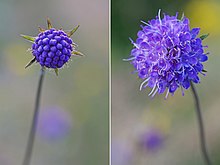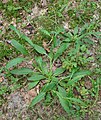| Succisa pratensis | |
|---|---|

| |
| Scientific classification | |
| Kingdom: | Plantae |
| Clade: | Tracheophytes |
| Clade: | Angiosperms |
| Clade: | Eudicots |
| Clade: | Asterids |
| Order: | Dipsacales |
| Family: | Caprifoliaceae |
| Genus: | Succisa |
| Species: | S. pratensis |
| Binomial name | |
| Succisa pratensis Moench | |
| Synonyms | |
List
| |
Succisa pratensis, also known as devil's-bit or devil's-bit scabious, is a flowering plant in the honeysuckle family Caprifoliaceae. It differs from other similar species in that it has four-lobed flowers, whereas Scabiosa columbaria (small scabious) and Knautia arvensis (field scabious) have five lobes and hence it has been placed in a separate genus in the same family. It also grows on damper ground.
Name
Species of scabious were used to treat scabies, and other afflictions of the skin including sores caused by the bubonic plague. The word scabies comes from the Latin word for "scratch" (scabere). In folk tales, the short black root was bitten off by the devil, for various reasons: anger at the plant's ability to cure these ailments, anger against the Virgin Mary, or as part of some 'devilish plot'. The Latin specific epithet pratensis literally means "of the meadow".
Description
Succisa pratensis is a herbaceous perennial up to 1m tall, growing from a basal rosette of simple or distantly-toothed, lanceolate leaves. Its unlobed leaves distinguish it from Knautia arvensis (field scabious). The plant may be distinguished from Centaurea scabiosa (greater knapweed) by having its leaves in opposite pairs, not alternate as in knapweed. The bluish to violet (occasionally pink) flowers are borne in tight compound flower heads or capitula. Individual flowers are tetramerous, with a four-lobed epicalyx and calyx and a four-lobed corolla. Male and female flowers are produced on different flower heads (gynodioecious), the female flower heads being smaller. The flowering period in the British Isles is from June until October.
Distribution
Succisa pratensis is common throughout most of the British Isles, western and central Europe, extending eastwards into central Asia. It is absent from eastern Asia. It has been introduced to eastern North America.
Ecology
It grows in wet or dry grassland and heath on acid or basic soils and is found in hedgerows, marshes, meadows and pastures.
The flowers are visited by various types of insects, but especially frequently by hoverflies of the genus Eristalis. It is a good source of nectar and is the larval food plant of the marsh fritillary, the eggs of which are laid in groups on the underside of the plant, and the narrow-bordered bee hawk-moth (Hemaris tityus). As both invertebrates are rare, their survival relies on careful management of sites containing these plant and butterfly species.
Fungal and oomycetous pathogens

The leaves are parasitized by the chytrid fungus Synchytrium succisae, the powdery mildew Erysiphe knautiae, the rust fungus Aecidium succisae, and the leaf spot fungi Fusicladium consors, Ramularia succisae, Septoria succisicola, and Septoria scabiosicola. The flowers are parasitised by the smut fungi Microbotryum succisae and Microbotryum flosculorum, and the downy mildew Peronospora violacea.
Management
| This section needs additional citations for verification. Please help improve this article by adding citations to reliable sources in this section. Unsourced material may be challenged and removed. Find sources: "Succisa pratensis" – news · newspapers · books · scholar · JSTOR (November 2018) (Learn how and when to remove this message) |
The aim is to produce an uneven patchwork of short and long vegetation by the end of the grazing period, between 8 and 25 cm (3.1 and 9.8 in). This is to allow the devil's bit scabious food plant to grow.
This can be achieved through low intensity grazing (also known as extensive grazing) using cattle. Sheep are not so good as they are more efficient at removing wild plants.
Gallery
-
 Bloom
Bloom
-
 Succisa pratensis on the German island Hiddensee
Succisa pratensis on the German island Hiddensee
-
 White-flowered form with the honey bee
White-flowered form with the honey bee
-
 Foliage in situ showing leaf arrangement
Foliage in situ showing leaf arrangement
-
 Closeup
Closeup
-
 Underside
Underside
-
 Flower at bud stage
Flower at bud stage
-
 Flower in full bloom
Flower in full bloom
References
- "Succisa pratensis Moench". Plants of the World Online. Board of Trustees of the Royal Botanic Gardens, Kew. 2017. Retrieved 23 September 2020.
- Wild Flowers of Britain and Ireland by Rae Spencer Jones and Sarah Cuttle
- The Illustrated Wild Flower Finder's Calendar
- Kingfisher Field Guides - Wild Flowers of Britain and Northern Europe
- The I-Spy Guide to Wild Flowers by Michelin
- Wild Flowers of Britain by Roger Phillips
- Wild Flowers of Britain and Ireland by Marjorie Blamey, Richard Fitter, Alastair Fitter
- Harrison, Lorraine (2012). RHS Latin for Gardeners. United Kingdom: Mitchell Beazley. ISBN 978-1845337315.
- Usborne Spotter's Handbook of Birds, Trees, Wildflowers
- ^ Stace, C. A. (2010). New Flora of the British Isles (Third ed.). Cambridge, U.K.: Cambridge University Press. p. 796. ISBN 9780521707725.
- A photographic guide to Wildflowers of Britain and Europe by Paul Sterry and Bob Press
- Clapham, A.R.; Tutin, T.G.; Warburg, E.F. (1981). Excursion Flora of the British Isles (Third ed.). Cambridge University Press. ISBN 0521232902.
- Anderberg, Arne. "Succisa pratensis Moench Sw". Naturhistoriska riksmuseet, Stockholm.
- NRCS. "Succisa pratensis". PLANTS Database. United States Department of Agriculture (USDA). Retrieved 4 December 2015.
- Clapham, A.R., Tutin, T.G. and Warburg, E.F. 1968. Excursion Flora of the British Isles. Cambridge University Press. ISBN 9780521046565
- Van Der Kooi, C. J.; Pen, I.; Staal, M.; Stavenga, D. G.; Elzenga, J. T. M. (2015). "Competition for pollinators and intra-communal spectral dissimilarity of flowers". Plant Biology. 18 (1): 56–62. doi:10.1111/plb.12328. PMID 25754608.
- Howarth, T.G.1973. South's British Butterflies. p129. Frederick Warne & Co. Ltd. ISBN 0-7232-1499-9
- Searle, Mark. "Marsh Fritillary". butterfly-conservation.org. Retrieved 9 September 2018.
- Gor, Adam. "Narrow-bordered Bee Hawk-moth". Butterfly Conservation. Retrieved 9 September 2018.
- Karling, J.S. 1964. Synchytrium.Academic Press: New York.
- ^ Ellis, W. N. (2024). "Succisa pratensis". bladmineerders.nl. Retrieved 13 September 2024.
External links
- [REDACTED] Data related to Succisa pratensis at Wikispecies
- The Plant Press Natural England Website
| Taxon identifiers | |
|---|---|
| Succisa pratensis |
|